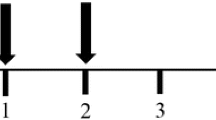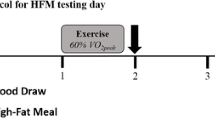Abstract
Postprandial lipemia (PPL) is associated with impaired endothelial function and inflammation. Acute exercise reduces PPL in adults. This investigation examined the effect of an acute bout of exercise on postprandial changes in triglycerides (TG), glucose, insulin, inflammation [white blood cell count (WBC), interleukin-6 (IL-6) tumor necrosis factor-alpha, C-reactive protein (CRP)] and endothelial activation [soluble intercellular adhesion molecule-1 (sICAM-1), vascular adhesion molecule-1 (sVCAM-1)] following a high-fat meal in adolescents. Ten normal weight (NW) (BMI, 20.9 ± 1.7 kg m−2; 15.6 ± 0.7 years) and eight overweight (OW) (BMI, 28.3 ± 3.6 kg m−2; 15.9 ± 0.4 years) adolescent boys underwent two 6-h oral fat tolerance tests (OFTT) separated by 7–10 days. On the evening prior to each OFTT, subjects either rested or completed a treadmill exercise bout (65% \( \dot{V}{\text{O}}_{2\max } ; \) 600 kcal expended). Exercise reduced (P < 0.01) the postprandial TG area under the curve by ~20% in the NW and OW groups. The postprandial glucose and insulin response did not differ between the control and exercise trials or between the NW and OW groups. Circulating leukocytes and plasma IL-6 levels increased (P < 0.01) in the NW and OW groups 6 h following the OFTT in both experimental conditions. There were no changes in CRP, sVCAM-1 or sICAM-1 following the OFTT and there were no differences between experimental condition or NW and OW groups. In conclusion, a moderate exercise bout prior to a high-fat meal effectively reduces postprandial TG concentrations to a similar degree in both NW and OW adolescents, but does not reduce the concomitant postprandial increase in WBC or IL-6.


Similar content being viewed by others
References
Aldred HE, Perry IC, Hardman AE (1994) The effect of a single bout of brisk walking on postprandial lipemia in normolipidemic young adults. Metabolism 43:836–841. doi:10.1016/0026-0495(94)90263-1
American College of Sports Medicine (2000) Guidelines for exercise testing and prescription, 6th. edn. Lippincott Williams and Wilkins, Baltimore
Bansal S, Buring JE, Rifai N, Mora S, Sacks FM, Ridker PM (2007) Fasting compared with nonfasting triglycerides and risk of cardiovascular events in women. JAMA 298:309–316. doi:10.1001/jama.298.3.309
Barrett LA, Morris JG, Stensel DJ, Nevill ME (2007) Exercise and postprandial plasma triacylglycerol concentrations in healthy adolescent boys. Med Sci Sports Exerc 39:116–122. doi:10.1249/01.mss.0000240327.31276.18
Blackburn P, Lamarche B, Couillard C, Pascot A, Tremblay A, Bergeron J, Lemieux I, Despres JP (2003) Contribution of visceral adiposity to the exaggerated postprandial lipemia of men with impaired glucose tolerance. Diabetes Care 26:3303–3309. doi:10.2337/diacare.26.12.3303
Carroll MF, Schade DS (2003) Timing of antioxidant vitamin ingestion alters postprandial proatherogenic serum markers. Circulation 108:24–31. doi:10.1161/01.CIR.0000074221.68903.77
Ceriello A, Quagliaro L, Piconi L, Assaloni R, Da Ros R, Maier A, Esposito K, Giugliano D (2004) Effect of postprandial hypertriglyceridemia and hyperglycemia on circulating adhesion molecules and oxidative stress generation and the possible role of simvastatin treatment. Diabetes 53:701–710. doi:10.2337/diabetes.53.3.701
Chen W, Jump DB, Grant MB, Esselman WJ, Busik JV (2003) Dyslipidemia, but not hyperglycemia, induces inflammatory adhesion molecules in human retinal vascular endothelial cells. Invest Ophthalmol Vis Sci 44:5016–5022. doi:10.1167/iovs.03-0418
Cole TJ, Bellizzi MC, Flegal KM, Dietz WH (2000) Establishing a standard definition for child overweight and obesity worldwide: international survey. BMJ 320:1–6. doi:10.1136/bmj.320.7244.1240
Couillard C, Bergeron N, Prud’homme D, Bergeron J, Tremblay A, Bouchard C, Mauriège P, Després JP (1998) Postprandial triglyceride response in visceral obesity in men. Diabetes 47:953–960. doi:10.2337/diabetes.47.6.953
Desideri G, De Simone M, Iughetti L, Rosato T, Iezzi ML, Marinucci MC, Cofini V, Croce G, Passacquale G, Necozione S, Ferri C (2005) Early activation of vascular endothelial cells and platelets in obese children. J Clin Endocrinol Metab 90:3145–3152. doi:10.1210/jc.2004-1741
Dill DB, Costill DL (1974) Calculation of percentage changes in volumes of blood, plasma, and red cells in dehydration. J Appl Physiol 37:247–248
Friedewald WT, Levy RI, Fredrickson DS (1972) Estimation of the concentration of low-density lipoprotein cholesterol in plasma, without use of the preparative ultracentrifuge. Clin Chem 18:499–502
Gill JMR, Hardman AE (2003) Exercise and postprandial lipid metabolism: an update on potential mechanisms and interactions with high-carbohydrate diets. J Nutr Biochem 14:122–132. doi:10.1016/S0955-2863(02)00275-9
Gill JMR, Caslake MJ, McCallister C, Tsofliou F, Ferrell WR, Packard CJ, Malkova D (2003a) Effects of short-term detraining on postprandial metabolism, endothelial function, and inflammation in endurance-trained men: dissociation between changes in triglyceride metabolism and endothelial function. J Clin Endocrinol Metab 88:4328–4335. doi:10.1210/jc.2003-030226
Gill J, Herd SL, Vora V, Hardman AE (2003b) Effects of a brisk walk on lipoprotein lipase activity and plasma triglyceride concentrations in the fasted and postprandial states. Eur J Appl Physiol 89:184–190. doi:10.1007/s00421-002-0788-9
Gill J, Al-Mamari A, Ferrell W, Cleland S, Packard C, Sattar N, Petrie J, Caslake M (2004) Effects of prior moderate exercise on postprandial metabolism and vascular function in lean and centrally obese men. J Am Coll Cardiol 44:2375–2382. doi:10.1016/j.jacc.2004.09.035
Glowinska B, Urban M, Koput A, Galar M (2003) New atherosclerosis risk factors in obese, hypertensive and diabetic children and adolescents. Atherosclerosis 167:275–286. doi:10.1016/S0021-9150(03)00003-0
Katsanos CS, Grandjean PW, Moffatt RJ (2004) Effects of low and moderate exercise intensity on postprandial lipemia and postheparin plasma lipoprotein lipase activity in physically active men. J Appl Physiol 96:181–188. doi:10.1152/japplphysiol.00243.2003
Lanes R, Paoli M, Carrillo E, Villaroel O, Palacios A (2004) Peripheral inflammatory and fibrinolytic markers in adolescents with growth hormone deficiency: relation to postprandial lipemia. J Pediatr 145:657–661. doi:10.1016/j.jpeds.2004.07.037
Leeuwenberg J, Smeets E, Neefjes J, Shaffer M, Cinek T, Jeunhomme T, Ahern T, Buurman WA (1992) E-selectin and intercellular adhesion molecule-1 are released by activated human endothelial cells in vitro. Immunology 77:543–549
Libby P, Ridker PM, Maseri A (2002) Inflammation and atherosclerosis. Circulation 105:1135–1143. doi:10.1161/hc0902.104353
Marchesi S, Lupattelli G, Lombardini R, Roscini AR, Siepi D, Vaudo G, Pirro M, Sinzinger H, Schillaci G, Mannarino E (2003) Effects of fenofibrate on endothelial function and cell adhesion molecules during post-prandial lipemia in hypertriglyceridemia. J Clin Pharm Ther 28:419–424. doi:10.1046/j.0269-4727.2003.00512.x
Matthews DR, Hosker JP, Rudenski AS, Naylor BA, Treacher DF, Turner RC (1985) Homeostasis model assessment: insulin resistance and beta-cell function from fasting plasma glucose and insulin concentrations in man. Diabetologia 28:412–419. doi:10.1007/BF00280883
Meydani M (2003) Soluble adhesion molecules: surrogate markers of cardiovascular disease? Nutr Rev 61:63–68. doi:10.1301/nr.2003.febr.63-68
Moers A, Fenselau S, Schrezenmeir J (1997) Chylomicrons induce E-selectin and VCAM-1 expression in endothelial cells. Exp Clin Endocrinol Diabetes 105(Suppl 2):35–37
Molnár D, Schutz Y (1997) The effect of obesity, age, puberty and gender on resting metabolic rate in children and adolescents. Eur J Pediatr 156:376–381. doi:10.1007/s004310050618
Moreno L, Quintela I, Fleta J, Sarria A, Roda L, Giner A, Bueno M (2001) Postprandial triglyceridemia in obese and non-obese adolescents. Importance of body composition and fat distribution. J Pediatr Endocrinol Metab 14:193–202
Nappo F, Esposito K, Cioffi M, Giugliano G, Molinari AM, Paolisso G, Marfella R, Guigliano D (2002) Postprandial endothelial activation in healthy subjects and in type 2 diabetic patients: role of fat and carbohydrate meals. J Am Coll Cardiol 39:1145–1150. doi:10.1016/S0735-1097(02)01741-2
Nordestgaard BG, Benn M, Schnohr P, Tybjaerg-Hansen A (2007) Nonfasting triglycerides and risk of myocardial infarction, ischemic heart disease, and death in men and women. JAMA 298:299–308. doi:10.1001/jama.298.3.299
O’Brien KD, O’Gorman DJ, Hughes SM, Monedero J, O’Connor PL, Pankratieva E, Whelan M, Nelson N, Walsh TG, MacEneaney OJ, Woods C, Moyna NM (2006) Inflammatory markers and adhesion molecules correlate with BMI and aerobic fitness levels in Irish adolescents. Med Sci Sports Exerc 38:S2302
Patsch JR, Miesenbock G, Hopferweiser T, Muhlberger V, Knapp E, Dunn JK, Gotto AM, Patsch W (1992) Relation of triglyceride metabolism and coronary artery disease: studies in the postprandial state. Arterioscler Thromb 12:1336–1345
Pedersen BK, Steesburg A, Fischer C, Keller C, Keller P, Plomgaard P, Wolsk-Petersen E, Febbraio M (2004) The metabolic role of IL-6 produced during exercise: is IL-6 an exercise factor? Proc Nutr Soc 63:263–267. doi:10.1079/PNS2004338
Peronnet F, Massicote D (1991) Table of nonprotein respiratory quotient: an update. Can J Sport Sci 16:23–29
Petitt DS, Cureton KJ (2003) Effects of prior exercise on postprandial lipemia: a quantitative review. Metabolism 52:418–424. doi:10.1053/meta.2003.50071
Potts JL, Coppack SW, Fisher RM, Humphreys SM, Gibbons GF, Frayn KN (1995) Impaired postprandial clearance of triacylglycerol-rich lipoproteins in adipose tissue in obese subjects. Am J Physiol 268:E588–E594
Seip R, Mair K, Cole TG, Semenkovich CF (1997) Induction of human skeletal muscle lipoprotein lipase gene expression by short-term exercise is transient. Am J Physiol 272:E255–E261
Sorenson KE, Celermajer DS, Georgakopoulos D, Hatcher G, Betteridge DJ, Deanfield J (1994) Impairment of endothelium-dependent dilation is an early event in children with familial hypercholesterolemia and is related to the lipoprotein(a) level. J Clin Invest 93:50–55. doi:10.1172/JCI116983
Sternby NH, Fernandez-Britto JE, Nordet P (1999) Pathological determinants of atherosclerosis in youth (PBDAY Study), 1986–96. Bull World Health Organ 77:250–257
Tolfrey K, Doggett A, Boyd C, Pinner S, Sharples A, Barrett L (2008) Postprandial triacylglycerol in adolescent boys: a case for moderate exercise. Med Sci Sports Exerc 40:1049–1056. doi:10.1249/MSS.0b013e31816770fe
Tsai W-C, Li Y-H, Lin C-C, Chao T-H, Chen J-H (2004) Effects of oxidative stress on endothelial function after a high-fat meal. Clin Sci 106:315–319. doi:10.1042/CS20030227
Umpaichitra V, Banerji M, Castells S (2004) Postprandial hyperlipidemia after a fat loading test in minority adolescents with type 2 diabetes mellitus and obesity. J Pediatr Endocrinol Metab 17:853–864
van Oostrom AJHHM, Sijmonsma TP, Verseyden C, Jansen EHJM, de Koning EJP, Rabelink TJ, Cabezas MC (2003) Postprandial recruitment of neutrophils may contribute to endothelial dysfunction. J Lipid Res 44:576–583. doi:10.1194/jlr.M200419-JLR200
van Oostrom AJHHM, van Wijk JPH, Cabezas MC (2004) Lipaemia, inflammation and atherosclerosis: novel opportunities in the understanding and treatment of atherosclerosis. Drugs 64:19–41. doi:10.2165/00003495-200464002-00004
Vogel RA (1997) Coronary risk factors, endothelial function, and atherosclerosis: a review. Clin Cardiol 20:426–432. doi:10.1002/clc.4960200505
Watson C, Whittaker S, Smith N, Vora AJ, Dumonde DC, Brown KA (1996) IL-6 acts on endothelial cells to preferentially increase their adherence for lymphocytes. Clin Exp Immunol 105:112–119. doi:10.1046/j.1365-2249.1996.d01-717.x
Weir JB (1949) New methods for calculating metabolic rate with special reference to protein metabolism. J Physiol 109:1–9
Zhang JQ, Thomas TR, Ball SD (1998) Effect of exercise timing on postprandial lipemia and HDL cholesterol subfractions. J Appl Physiol 85:1516–1522
Zhang JQ, Nunez G, Feathers S, Hart CL, Yao WX (2004) Effect of exercise timing on postprandial lipemia in hypertriglyceridemic men. Can J Appl Physiol 29:590–603
Zilversmit DB (1979) Atherogenesis: a postprandial phenomenon. Circulation 60:473–485
Zilversmit DB (1995) Atherogenic nature of triglycerides, postprandial lipidemia, and triglyceride-rich remnant lipoproteins. Clin Chem 41:153–158
Acknowledgments
We would like to thank all of the subjects who participated in the study as well as Martin Duggan, Willie Guerin, John Horan, Colm Keogh, Dermot Morris, and Brian Talty for their invaluable assistance. This study was supported by The Irish Research Council for Science, Engineering and Technology and the EMBARK Initiative, funded by the National Development Plan.
Conflict of interest statement
The authors declare that they have no conflict of interest.
Author information
Authors and Affiliations
Corresponding author
Rights and permissions
About this article
Cite this article
MacEneaney, O.J., Harrison, M., O’Gorman, D.J. et al. Effect of prior exercise on postprandial lipemia and markers of inflammation and endothelial activation in normal weight and overweight adolescent boys. Eur J Appl Physiol 106, 721–729 (2009). https://doi.org/10.1007/s00421-009-1073-y
Accepted:
Published:
Issue Date:
DOI: https://doi.org/10.1007/s00421-009-1073-y




